| Join Our Vineyard Diary Mailing List |

| you can buy our wine in the UK by clicking here |
(6 October) The final day of our harvest. As predicted below the yield of barbera d'Asti this year is very low. Of the 2 hectares we have in production for 2008 we have taken a total of just 26 quintale (2,600 kg) - in a normal year we could expect about 16,000kg. I can also report that many in this region are reporting similar low yields. The more positive news is that the bunches we have chosen to pick are exceptional, with high sugar content (23 degrees) and with great complexity and character. So for 2008 we will make only a barbera d'asti "superiore", aged in oak barriques for at least a year. Post harverst I have been undertaking the remontage twice a day (where I pump the grape must over the cap of grape skins to keep it moist and to maximise the colour transfer from the skins. The colour is just fantastic (see below).

our barbera d'asti DOCG grapes in the fermenting tank
(5 October) Ok, another 12 hours of harvesting done. The grape bunches got better as we worked our way up the vineyards. So at one stage (after lunch) when fatigue is setting in, the fact we were working along rows with plentiful and undamaged barbera d'asti was a real spirit lifter. We also took twice as much yield this afternoon as we did in two half days (yesterday and this morning).
So quantity is very low, but the extreme selection means quality is very high, and our sugar content this year is through the roof. I suspect we wil make a barique "superiore" this year and nothing else.
Probably anothe half day to finish..
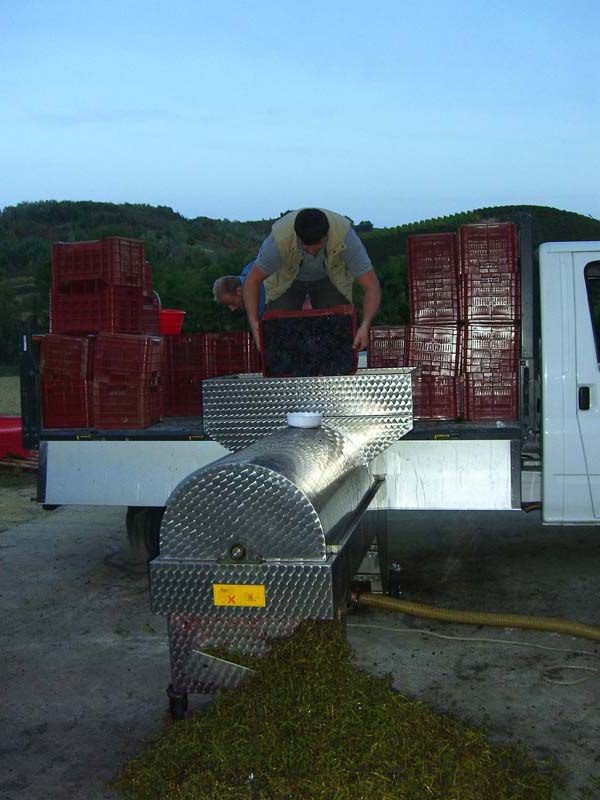
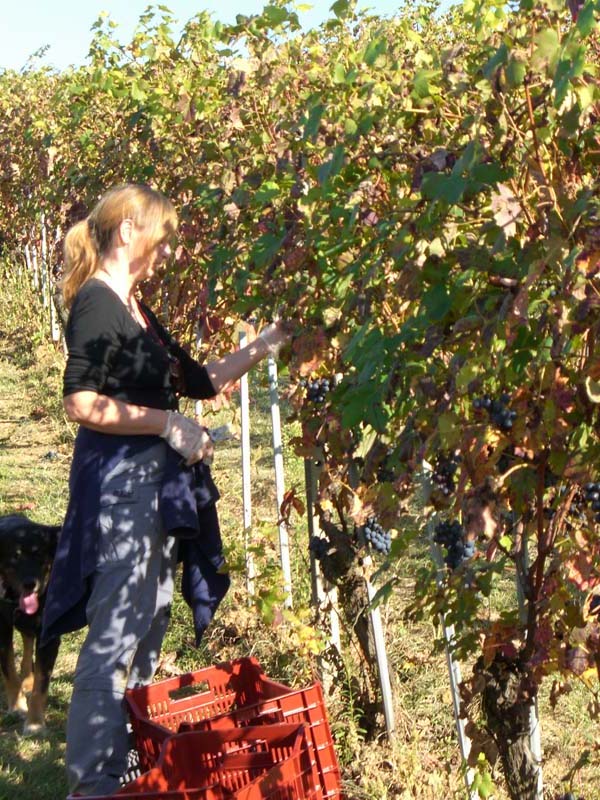
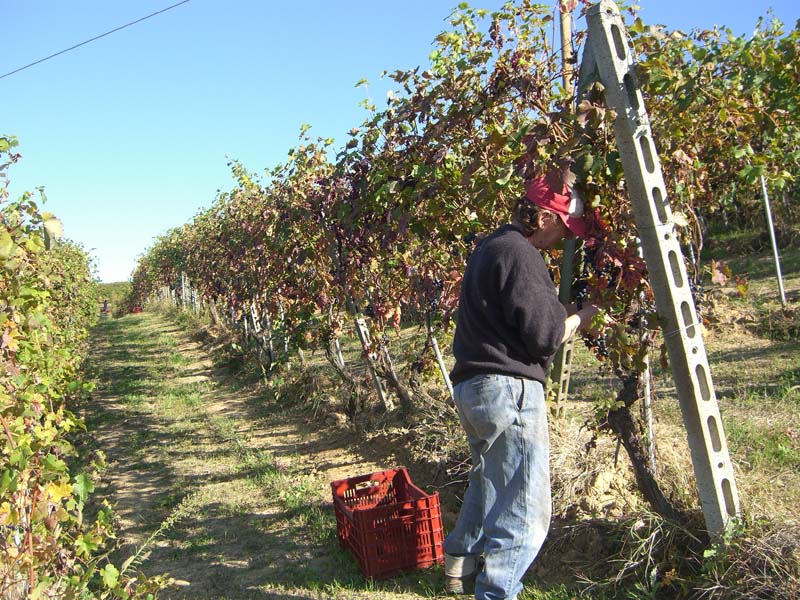
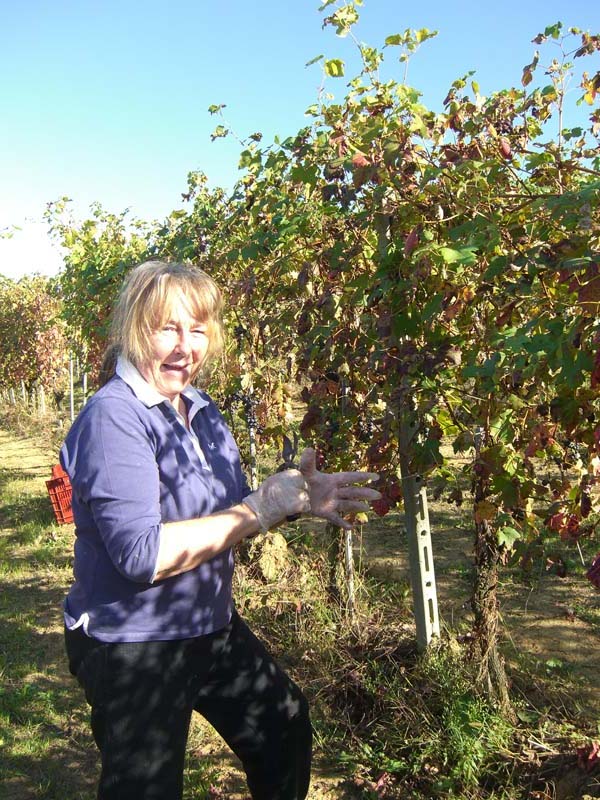

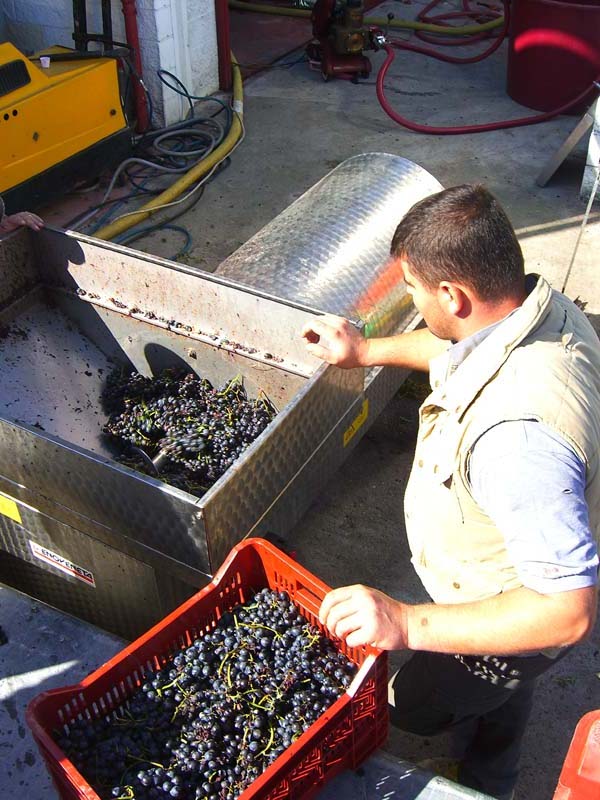
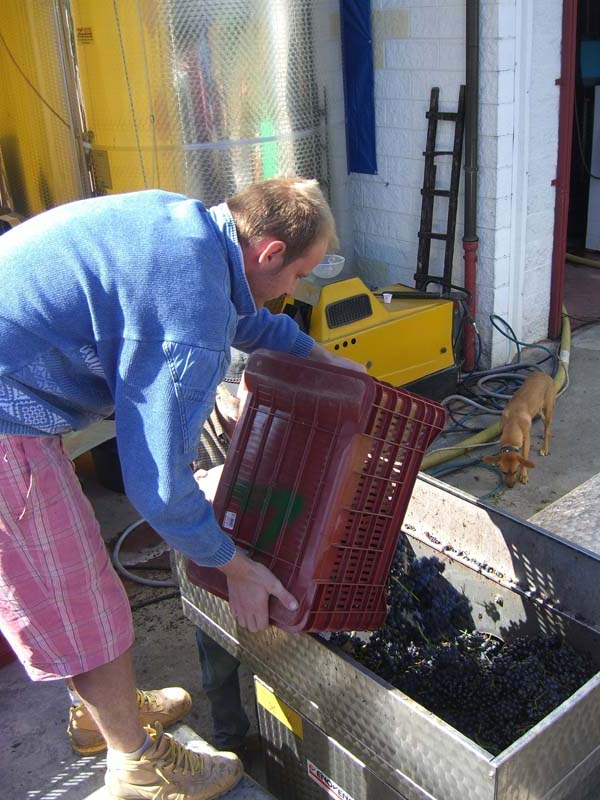
The month between our white and red harvest has flown by! Today (4 October) we started our Barbera d'Asti harvest. We started at lunchtime in good weatehr conditions, mid 20's centegrage, blue skies and a light breeze. We deliberately chose to start with our worst patch if vineyard - the 4 year old's below the pool in the sheltered location that has this year fallen foul of the conditions and has suffered most from Oedeo (Powdery Milldew). Now an hour or so after pausing for the night we are quite distraught - from a vienyard that yeilded 6,000 bottles last year I will be surprised if we see 1,000.
On a more positive note we are taking extreme care to only select bunches that are ripe and free of problems - perhaps the most rigerous selection we have ever made. Of course our paid pickers are not quite as focused on quality as we are (and beleive me I have been pointing out every fault I find) - so for 2 hours after every one left for the night Ingrid and I spent some time going throuigh each cassette further weeding out any bunches that we don't want before going into the vat. A lot of work, but the only way to make sure......

Ingrid checking every cassette of grapes for problems after today's Barbera d'Asti harverst
Now we arrive at the culmination of our year's work as harvest season starts.
Sep 8th - Two trailer loads of our precious Moscato d'Asti grapes are safely delivered to Cantina Cossetti who help us make our Moscato d'Asti DOCG wine. Relief is palpable as the grapes are inspected, tested and passed by the chief winemaker and we become the first Moscato client delivery of the 2008 vintage.
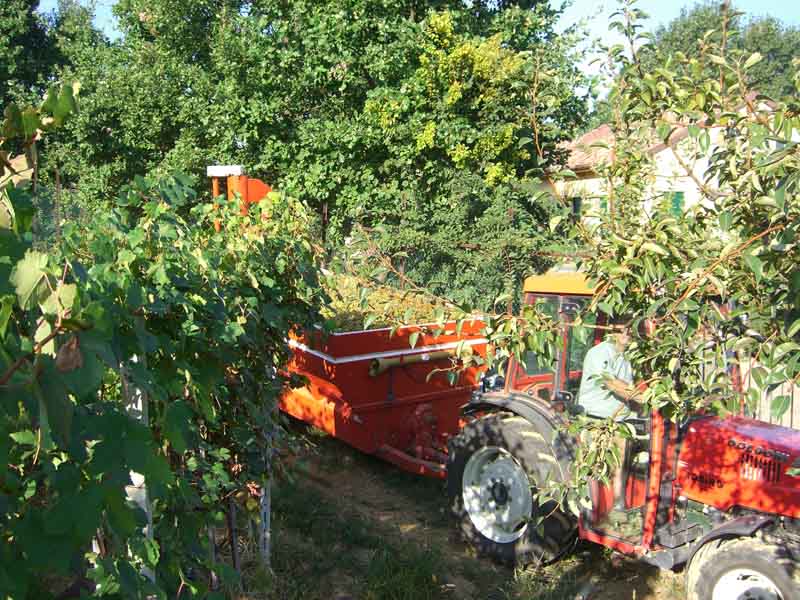 |
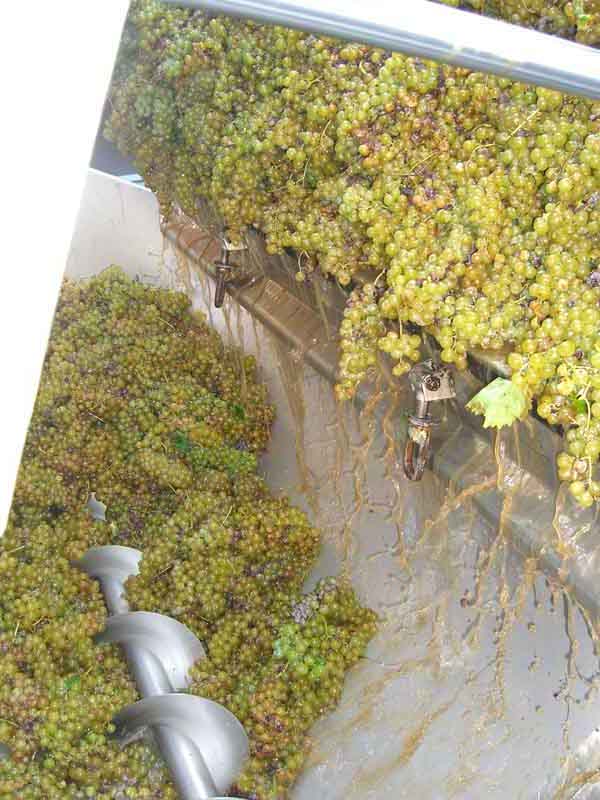 |
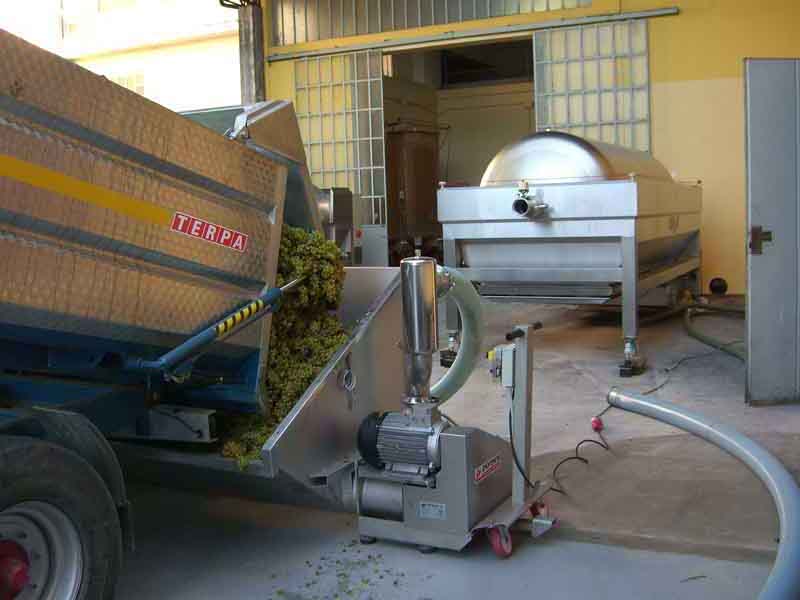 |
 |
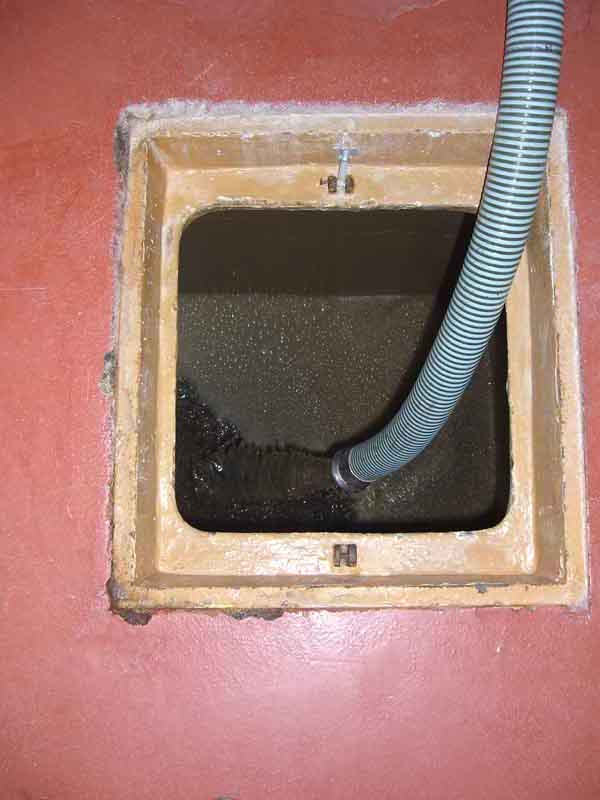 |
| Using photos from this years harvest we have created a story board of the winemaking process - see more |
Sep 7th - Harvest day - and thank goodness the weather has been kind to us! The past few days have been strong winds which have kept humidity at bay and dried any moisture on the bunches very nicely. Also the day itsself is great, no rain and not too hot, meaning we can pick all day. We get of to a shaky start as all the helpers that promissed to come do not turn up on time (a good Satruday night perhaps?). However by mid morning we have lots of help and we make good progress. After the obligotary pause for lunch more help arrives and we finish the complete veneyard (1 hectacre) by 5.30pm. We are not taking the grapes to the cantina untill the following morning, so clean up times are short and we can breath as sigh of relief that all the grapes are in safely.
Just in time (the day before harvest) I get the trauncher repaired and get the grass and weeds vut in the Moscato vineyard. This is not absouiltely essential but makes the job of picking the grapes much more comfortable and hopefully a little quicker.
In a year of challenges, another one is thrown at me as the machine we use for cutting the grass and weeds in the vineyard rows (the trauncher) goes terribly wrong. For the technically minded the transfer gearbox had a bearing collapse, very messy! Of course it takes me some time to work out the exact problem - another new skill learnt (dismantling machinery). I drive to the manufacturer, only 20 miles away - most vineyard machinery is made locally; to be given an outragous price for a totally new gearbox and an attractive price for a brand new trauncher. (Does this story sound familiar to car owners?). Anyway long story short - I find a local guy who can get me a replacement bearing and lend me enough tools to repair it myself. At the same time I borrow the right tool to tighten the chingalo tracks - so as everything seems to be reparred and working fine I am very pleased.
Sep 1st - in preperation for harvest we start to work our way through the Moscato d'Asti vineyard clearing most of the leaves from around the grape bunches. This has two functions, (1) now the grapes are all but mature we get maximum air flow around the grapes, keeping threat of rot (botrytus) to a minimum; and (2) when we start picking everyone involved can see the grapes easily, saving time for the day of harvest. This takes two of us about a week.
August 30th - Earlier in the month I talked about the Moscato d'Asti vineyard and botrytis ("the noble rot"). The good news is that this did not turn into a major outbreak, so the bunches still have good structure and are nicely mature. Of course we are now very close to harvest, so we; like all our neighbors, are worying about bad weather and conditions between now and safely picking the 2008 vintage. Our current plan is to pick the Moscato over the weekend of 6th and 7th Spetember. Lets see how the next week progresses!
August 13th – The mature moscato d’Asti bunches have started to develop botrytis, this is visible as a blue or grey grape appearing somewhere near the middle of the bunch. So we strip away foliage immediately around the vines and make a specific treatment to prevent these early symptoms becoming an outbreak that can decimate the crop. These past few days I have been focusing on the Barbera d’Asti vines (still struggling with the remenants of the powdery mildew outbreak) so the additional challenge for the (so far) excellent Moscato vineyard is most unwelcome. I will keep you posted on progress.
August 9th – A new toy! Desperate to catch up with work on canopy management I bought a foliage trimmer today. This is a petrol driven cutter of the type typically seen for cutting hedges. This is a great help (and may become a favourite tool) as it allows me to cut/trip a row of vines in about 10 minutes rather than the usual 90. Of course it is a lot heavier than a sickle so lets see how my arms hold up to 3 hectares of trimming.
August – On Tuesday 5th we had a huge storm sweep through bringing with is a typhoon that carved a line of destruction from the lower end of our Barbera d’Asti, throught (literally) the tractor garage and beyond. The damage included 3 trees dropped on top of our vines, the garage roof – totally destroyed and deposited for 30 metres through the vineyard above, a downed telegraph pole – plus three others that are now swaying in the breeze and a lot of vines that have been blow off the trellis work. Of course this is nature so we have to just get on and deal with it! We have temporarily made the garage watertight and are putting the vines back into order.
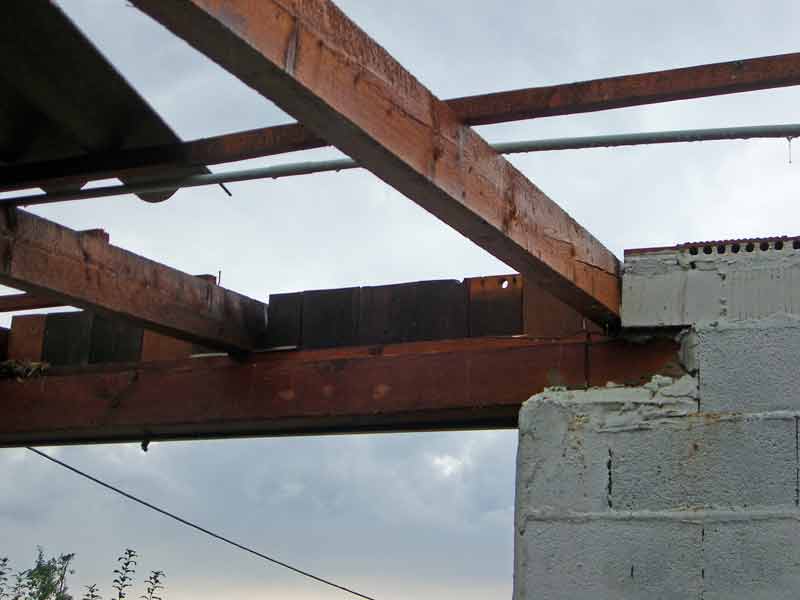 |
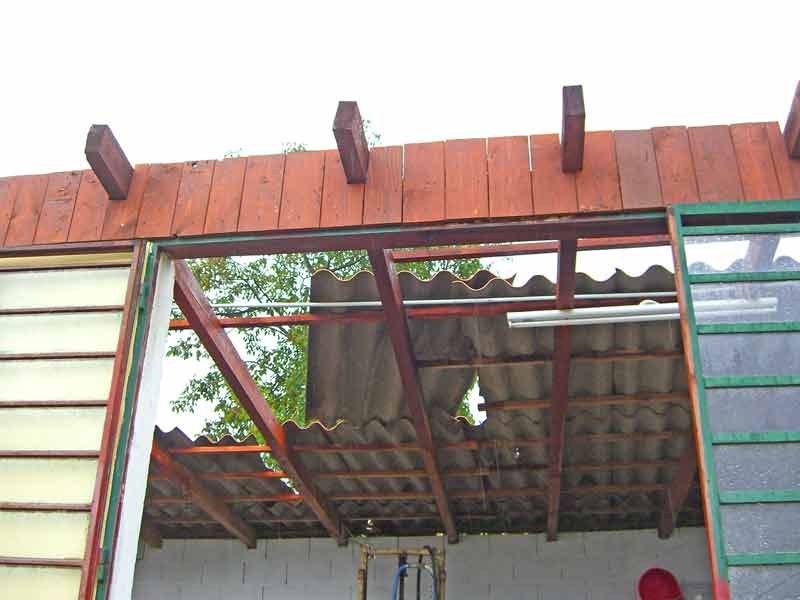 |
|
August 5th - storm
|
damage to tractor garage
|
August - "Fair August" has arrived and our local village celebrated in style this weekend. There is not much to celebrate in the vineyards I am afraid! The grapes are very late in maturing and we are struggling to combat powdery mildew in all the barbera vineyards. To give readers some idea of the differences between this year and last see the pictures below - the same vine taken 3 August 2007 and 3 August 2008 - the 2007 picture shows mature black grapes. The 2008 grapes are still green and not yet mature. This means that harvest will be late this year (it was very early last year), so we have to hope for a dry autumn to avoid further complications.
 |
|
|
Barbera d'Asti grapes - 3 August 2007
|
Barbera d'Asti grapes - 3 August 2008
|
July – The unseasonal “green” countryside continues into late July. Usually the terrain looks scorched and brown, but even today (24 July) it is possible to find some sheltered damp earth despite temperatures ranging between 25 and 38 degrees this month. Mornings still have a dew – almost unheard of in July and the vines (and the weeds) continue to shoot up and out at an alarming rate.
All this means that any hopes of a moments rest are impossible, the vines must be continually cut back and trained over the trellis and leaves nearest the bunches must be stripped off to allow light, air and “treatments” to get to them. Certainly this is the year of fungal invasion with foliage moist most mornings. The only solution is diligent spraying (organic copper sulphate) and repeated dustings (sulphur powder). The most back breaking feature is cutting away the grass and weeds immediately between the vines which is done with a sickle or a petrol driven brush cutter. The sickle is lighter, quieter and cheaper – but the brush cutter makes for a faster job with less bending.
In a diversion from the vineyard, this month I took time out to go and collect 4 new oak barrels, each of 500 litres. This was my first trip to the famous cooper – Gamba, and I was fortunate enough to meet the man himself (see photo). These new French oak barrels (Allier) will host the 2007 vintage “Piano Piano” Premium Reserve for the next 15 months.
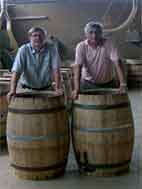
the author with Sr Gamba, master cooper of Piemonte
June – This month is a story of two halves, prior to the 17th the torrential rain and low temperatures were the same as the last half of May, the, as if someone had thrown a switch the remainder of the month was clear blue skies and temperatures in the mid to late 30’s Celsius.
In discussion with my fellow grape growers in the village (and they with their parents) it seems that there has not been a period of such contiguous daily rainfall (it lasted 22 days in total) for the past 40 years. The results are several including; (1) the loss of grapes from the young bunches detailed below; (2) a landscape of lush green that resembles late spring (where normally would be brown and scorched);(3) many valuable working days lost to rain and impassable mud; (4) and a number of fungal problems with the vines to deal with.
27th June – Not quite where we should be for this time of the season we are nonetheless relieved to have got the vineyards more or less into order and with all the necessary treatments undertaken to protect the vines from undue attack from virus and other malatia. A short pause now whilst the copper sulphate is absorbed by the vines before we start working on them again on Monday. Lets see what July brings!
23rd June – A near disaster in the vineyard as I rush to complete too many jobs at once. The weeds surrounding the vineyards are out of control and I was cutting them back (we need clear air and ground for at least 20 feet to discourage insect migration and other nasties from spreading from the undergrowth) . So I was running the chingallo and grass/weed cutter along the edge of a particularly steep edge when I lost the right hand track to an edge that had been eroded by all the rain. The shock of the tractor careering off course at an angle to the very steep slope was frightening, the left track was above my head when I decided to leap off the tractor expecting it to roll over at any moment!
Fortunately tractor and self are both OK (if a little shocked) and the chingallo came to a halt at a very unsafe angle. Subsequently Ingrid and I spent an hour in the scorching midday sun (28 degrees!) digging out a more level path to reverse the chingallo out and back to safer ground. I didn’t take a picture of the tractor at the crash scene, but here is one just after recovery with a view of the steep bank and groundwork we dug to recover it. I am suitably chastised about the extreme danger of using a chingallo and rushing.....
recovering the chingallo after it fell down the slope (left of picture)
21 June – Desperately trying to catch up on the foliage training, the problem is that when it is not done at the right time the job becomes 10 times as hard (it does not stop growing until the grapes change colour (Barbera grapes that is). As you will see on the picture below the before and after shot is quite a contrast – and we can’t get the tractor through these rows until the work is done.
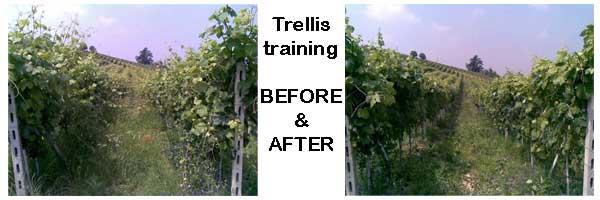
19 June – At long last the skies have cleared and the more usual blue skies and high temperatures have arrived. The valley is alive with the sound of tractors once again able to get into the vineyard and orchards. Today we have started treating the vines and foliage with a dry Zolfo (sulphur) powder – entirely organic and the best treatment for some of the white mildew powder that has started to appear on some of the grape bunches due to the sustained wet period. See pictures below of the “zolfo polvere” treatment.
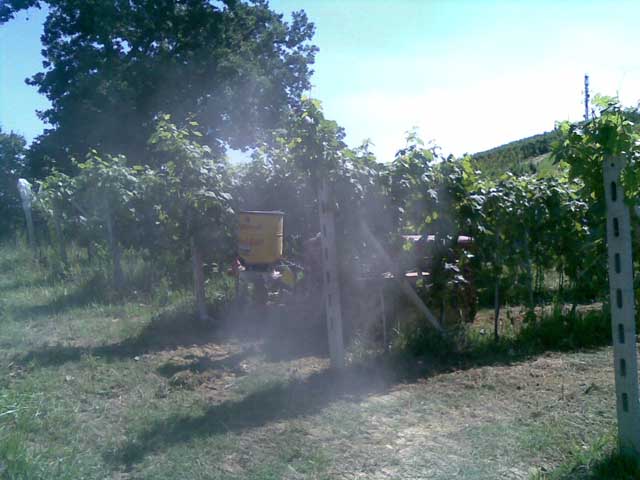 |
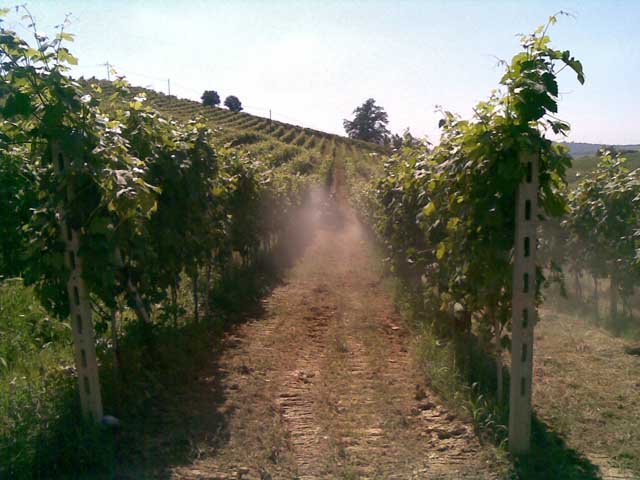 |
|
dry powder treatment with Zolfo
|
treatment with dry powder in our Barbera d'Asti vinyeyard
|
15 June – Although rain is still a threat we do have more “solid” ground underfoot, so we are able at long last to get the chingallo (our tracked tractor) back to work in the vineyards. There are many tasks to undertake, including a desperately needed dry powder treatment of Zolfo.
First I must cut down some of the grass and weeds that have flourished in the rains. In places the weeds are higher than the vines and trellis, so a dry powder treatment would not actually reach the vines due to the “weed barricade”! See photo’s below of the tractor hidden by weeds as I force a cutting path through.
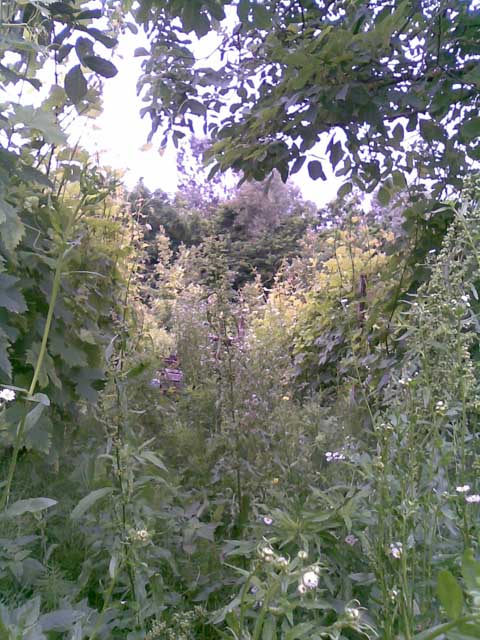 |
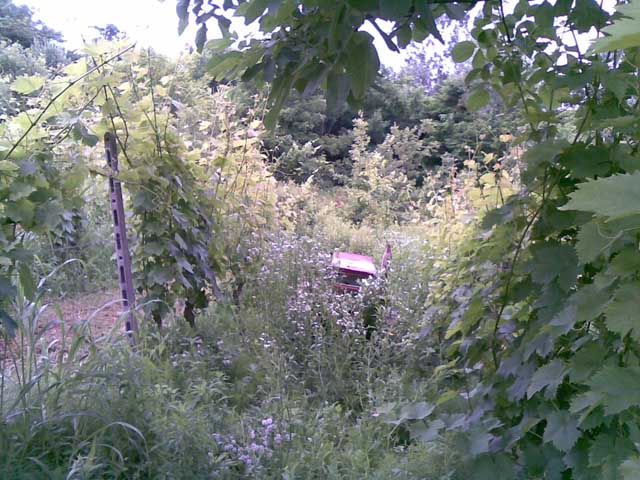 |
|
can you see the tractor? Look closely in the weeds (click to enlarge)
|
heary rain has encouraged weed growth - often as high as the vines here in our moscato d'asti vineyard
|
June 6th – Although we are still suffering from heavy rain the frequency is decreasing (raining overnight or for an hour a day – rather than continuously), so we are able to get into the vineyards and start to recover some of the lost time. One of the problems is that we are unable to “train” the vines over the trellis work when the leaves are wet as the winding and twining of the vines would trap moisture inside and risk an outbreak of “malatia” be it mildew or other fungal attack. So we wait for the leaves to dry and then start (in the meantime “plucking” leaves from the area around the young grapes to allow them to breath and get some sun).

A final paragraph on May – it turned out to be the wettest May on record and as I wrote earlier we did indeed have to rent a helicopter to undertake the spraying – twice! The heavy rains have also taken their toll on our youngest vines (the three year old and four year old Barbera d’Asti vineyards), we have lost at least 50% and as high as 70% of the grapes! These young vines are not as strong as the old vines so are more prone to the very young flowering grapes being literally washed off (see photo below). So as we move into June the forecast is for more storms, lets see what happens next!
 |
 |
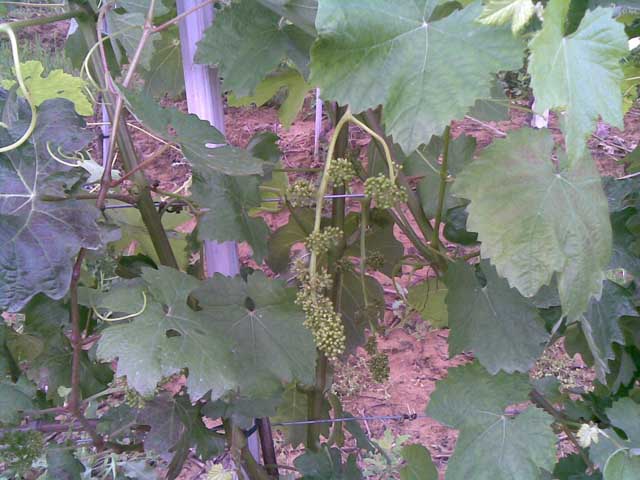 |
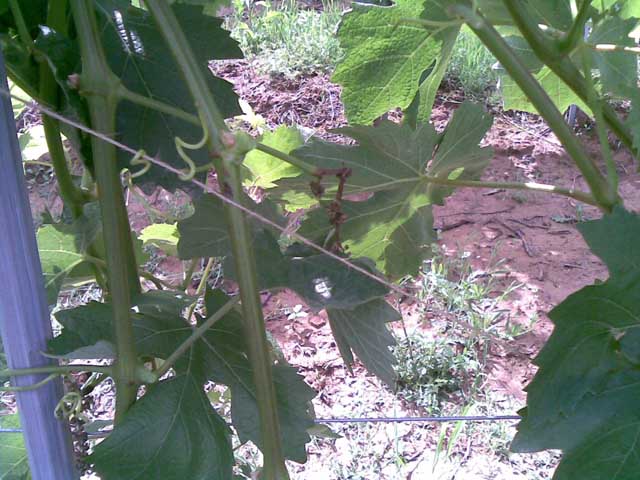 |
 |
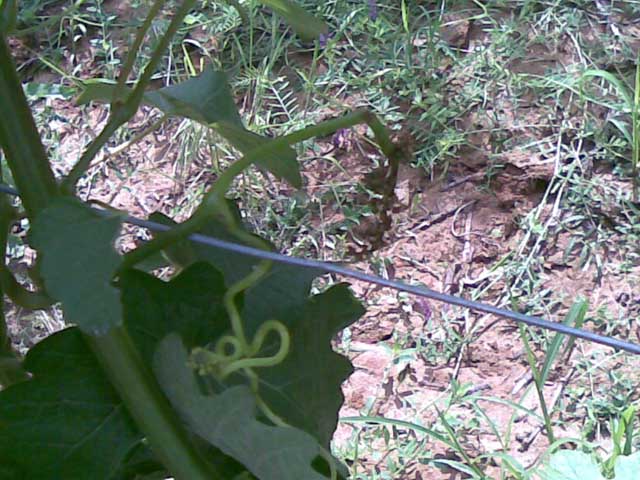 |
May – Over the past 3 years we have learnt that May and June are the busiest time in the vineyards. As spring moves towards summer the vines shoot up and that means a more than full time requirement to keep them in check and train them over the trellis wirework. This year seems like more work that last, for a couple of reasons. Firstly we have more vines reaching maturity, so the Barbera d’Asti planted 3 years ago will be cropping for the first time this year. Three year old vines are notable for their almost wild growth as their young vigour turns into Jack and the Beanstalk like proportions. Secondly we have had a remarkable amount of rain which has encouraged the vines (and the weeds) to greater growth.
23 May – A dry day for the first time in the last week! After last years drought we now have the other extreme with torrential rain preventing us from getting into the vineyards. We are franticly tying up the shooting vines and threading them back into the trellis work. There are two problems here, one the new growth is getting big and heavy so without support they will snap off (especially in heavy rain) and two, we need to get the tractor along the rows to spray. Talking of spraying we are desperate to spray with copper sulphate, but the ground is so waterlogged it is too dangerous. Yesterday I attended a meeting with all the local producers where we were discussing chartering a helicopter to undertake a spray!
12 May – we finally finish the “stripping off” of the old wood. Not only do our vines grow from the nicely pruned and trained “spur” of 2 year old wood, they also produce shoots from every possible crack and spur up and down the old wood of the vine. So all 15,000 or so vines have to be stripped of all surplus growth by hand. This is back breaking work as it is all at the base of the vines (the first 18 inches (45 cm) or so. As we work on each vine we also “nip out” any secondary shoots on the 2 year old spur (if you have ever grown tomatoes it is a similar exercise), and train the longer shoots through the wire trellis. Grass and weed growth is also taking off so it’s out with the tractor and trauncher to cut this all back wherever possible.
April - (28th) I was giving a tour of our vineyard to some visitors who came to buy some wine today when and lo and behold we have grapes! Well in fact we have the start of grapes, with the first flowering heads appearing, they are quite literally the baby grapes in the making. Since my last entry any concerns we had about another year of drought conditions have entirely gone away. We have had a sustained period of rain through much of April and the ground is now "fully charged" so if we did not get another drop of rain we would make it to harvest time with no problem - this is a good place to be.
Yesterday (27th) we had to undertake our first spray of the season. The temperatures are now up around the 20's but yesterday saw heavy colud and thus high humidity that was not burned off by sunshine. The younger vines are particularly suceptable to early stage rot so the two younger vineyards (3 year old and 4 year old Barbera d'Asti) each were sprayed with organic copper sulphate.
A few weeks ago we also managed to use the airiating plough on the moscato and barbera vineyards which was perfect timing as the predicted heavy rain then set in, so the opened up clay absorbed a lot more water than otherwise would have been the case. Of course the downside is that the weeds have also shot up with a veangance and literally everything has turned green again, oh and the insect poluation has also woken up!
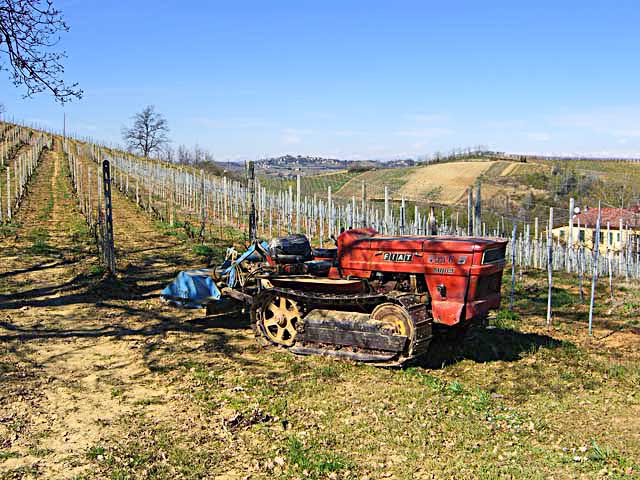
April - after what was the driest March on record our stress levels have been rather high worrying about the 400 baby vines we planted over the past weeks. Well the good news is that at last some rain has arrived (9 April) and several more wet days forecast. Although this prevents us from working in the vineyards - we are very relieved - and can spend a little time updating our website!
March - Spring is in full swing now (31st March) and buds are starting to appear on many of the vines. Interesting to see that bud break occurs earlier on the higher slopes. We have been busy planting replacement vines in the established vineyards. We spent a lot of time over the autumn and winter preparing to replace vines that had reached the end of their life or suffered from a mishap of one kind or another. In the established Barber d'Asti vineyard this involved using a mini-excavator to turn the soil to the required 1.4 metres without disturbing the other vines. After some surface preparation and weeding last week we planted 250 baby vines over the past weekend.
Once again we find ourselves in drought conditions with no rain since early March and very little even then. So yesterday I filled the water bowser used for our seasonal spray of the foliage and used it to water in the newly planted baby vines (barbatelli). This is the first time in four years of planting barbatelli that I have done this and I hope it will be sufficient to give these vines a good start.
Also during the week our ageing tractor (cingallo.) decided to casus us a few problems. Given that it is over 20 years old one cannot complain too much as it gives pretty faithful service. Basically two of the three studs holding the exhaust silencer (muffler) to the manifold had disintegrated or dropped off over time, so when the exhaust dropped off I thought I should do something about it. One thing about being a small winery is that you have to be a "jack of all trades" - we don't have the luxury of staff or machine shop and paying a dealer to do anything is the absolute last resort! So a little bit of on the job learning and some handy re-use of parts long ago hoarded in my garage and everything is as good as new. If only every vehicle was as easy to repair....
running repairs to the cingallo.
First weekend of March temperatures were 22 degrees C - almost unheard of and although the temperature is half that now the mild weather may well encourage an early spring. This is a concern for us as a late frost could then cause problems for budding vines.
We are almost finished with the tying down of vines, about half of the Barber d'Asti vineyard below the pool (the 2004 planted vineyard) remains to be completed. Rain arrived yesterday (Saturday 8 March) and so we are taking an enforced break (time to update the diary). Hopefully 1 more day will complete this phase, as we must get the canes finished before the vine comes back to full life and bud break. The mild weather may bring this on sooner than we would like.
We have also been busy clearing some of the scrub woods around the vineyards. The vineyard below the pool is now established (we took our first Barbera d'Asti grape harvest from this vineyard last year) and so we need to ensure light and air can reach all parts. In the area nearest the farmhouse the vines were surrounded on two sides by woods, so we have been clearing these away. As you will see from the photo this is a substantive amount. Aside from allowing more light we really should have at lease 20 feet from last vine to any other growth, this provides separation from insects and possible viral contagion.
Photo's - Clearing woods at the edge of the vineyards
February - Most days start cold (heavy frosts), but the clear skies mean bright sunshine and so we can happily work in the vineyards from about 10 in the morning. Progress has been good and all the vines, new and old are pruned. Most of the stripping off (last years vine growth/canopy) is finished and we have started with the tying down.
Photo - This years growth canes tied down in the Moscato d'Asti vineyard
Tying down involves taking the single long cane we have left on each vine as part of the annual pruning and bending it into a bow like shape down onto the lower wire of the trellis. We then tie the bow in place using a length of sapling cut from our willow trees. This process is part of the guyer training method and the use of natural willow as a tie one of the most traditional wine training techniques. Benefits include an entirely natural and sustainable source which biodegrade and the fact that the soft willow does not cut into the cane of the vine now tied under tension.
At the beginning of Feb. we had a little more snow, this is really good for the vineyards as the snow sits and provides a frozen layer which cuts down some of the overwintering weeks as the lose light and air, it also reduces the insect population. The main advantage though is in the slow release of water into the ground as it thaws. Often when we get rain a lot of the "benefit" runs off rather than soaking in, the gradual thaw is a better irrigation.
January - As the pruning in each vineyard is completed I make a concerted effort to strip off the old canopy as soon as possible, this means I can then start with the trellis wires. Each trellis wire has to be re-tensioned, all done by hand and involves unwinding each wine from its end post and pulling as tight as possible before re-binding to the post. As with all jobs in the vineyard this is a repetitive process where practice soon makes one more agile but nonetheless this is a long job which will go on till early March. Its not full time, but I will do each vineyard after pruning and stripping off and before tie down. In the Moscato d'Asti vineyard the trellis is a little different to the Barbera d'Asti - there are 6 trellis wires rather than 4, each has to be untied and tensioned and I repeat this at both end of the row. In the case of the longer rows this is actually four end posts as we have a break in the centre if each row. For those who like statistics this is something in the region of 75 rows in the Moscato d'Asti making it 150 end posts and some 900 individual galvanised wires to unfasten, pull on and rebind. Of course this helps reduce the extra pounds on may have put on at Christmas.
photo - Ingrid strips off last years growth in the Barber d'Asti,
can you spot Edilio behind her cutting new growth willow for the tying down of this years canes.
Early January brings a lot of snow, it takes us about 3 days to dig ourselves out, fortunately we are used to being snowed in so being cut off from the outside world is not a great hardship. Once it has actually stopped snowing we can work in the snow which brightens the landscape to stunning levels.
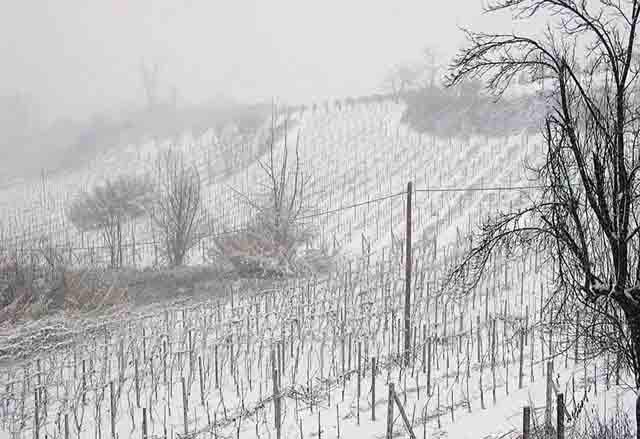
A winter scene - our Barbera d'Asti vineyard in January
HOME | ACCOMMODATION | ABOUT PIEDMONT | BUY OUR WINE | FOOD | PICTURES
SPECIAL EVENTS 2008 | FRIENDS & NETWORKS | NEWS & REVIEWS | LINKS | CONTACT US
site map downloadable vineyard calander distances from airports to our vineyard
Download our 2008 brochure about our Piedmont B&B and what to see and do in Piedmont in pdf format
Moscato d'Asti harvest 2007 - clik4pics
Piedmont Barbera d'Asti harvest 2007 - clik4pics
vineyard courses - Winter sales - food & wine -Special events and breaks
we wish you very a pleasant stay in piedmont